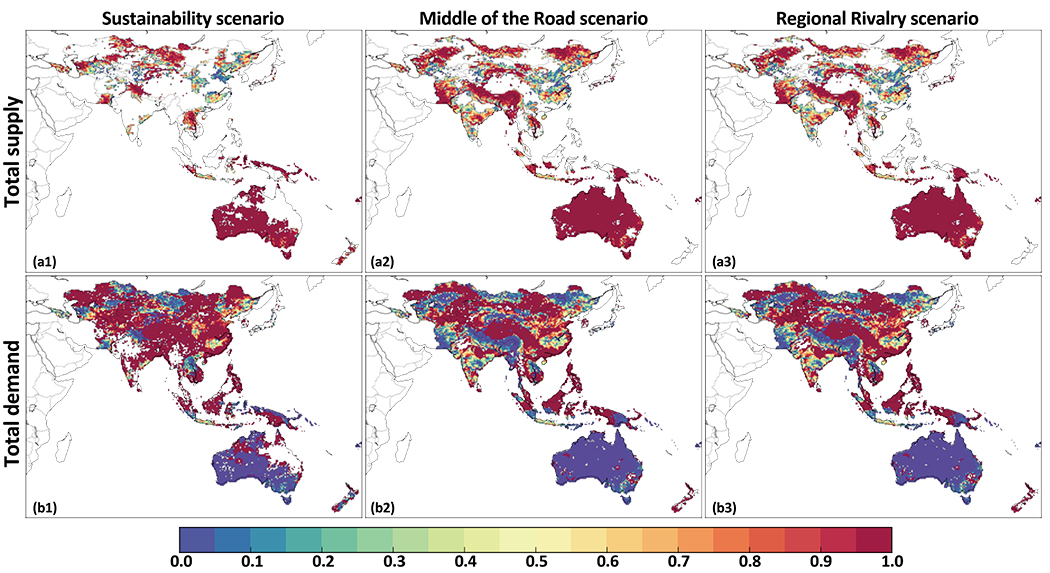
Asia’s looming water crisis
Climate and socioeconomic change is expected to contribute to water stress in Asia, which means that between 1.6 and 2 billion people could potentially experience severe water stress conditions by 2050. By applying water use scenarios developed by the Water Futures and Solutions Initiative, IIASA researchers for the first time highlighted that socioeconomic change could be the main driver of worsening water security in the region.
Home to almost 4.5 billion people, Asia has experienced unprecedented economic and population growth in recent decades. This has in turn resulted in a substantial increase in water use. Imminent changes due to climate change and socioeconomic development in the region are expected to put even more pressure on water resources in the coming decades. This makes it imperative to evaluate future water scarcity and identify regions at risk in order to inform management strategies, adaptation policies, and planning for sustainable development.
By focusing on Asia as part of a global analysis [1], this study assessed three possible Asian water futures based on a set of consistent and comprehensive climate and socioeconomic projections using three global hydrological models [2]. As part of the modeling process, the researchers extended the latest socioeconomic projections in terms of water, as the original data did not provide enough information for their water use projections. They then combined these extended projections with the latest climate change scenarios using the methodological framework of the IIASA Water Futures and Solutions (WFaS) initiative.
The results highlight that socioeconomic changes have the most significant impacts on water demand growth and overall water stress in hotspots in Asia. While population will peak in some countries before 2050, population and gross domestic product (GDP) are expected to increase in almost all countries across Asia. The resultant growth in, and around mega cities especially, is obvious. Depending on which scenario is applied, industrial and municipal water demands are projected to increase from current levels by between 136-167% or 176-245%.
Climate change is projected to put additional pressure on water resources. In a medium emission scenario, one-third less surface water resources will be available by 2050, when compared to low emissions scenarios. This gap is projected to grow towards the end of the century. Climate change will also result in an increased demand for water in agriculture.
The rapid growth in water demand, in combination with the reduction in available water supply, is expected to increase water stress in Asia considerably, with 20% of the land area subject to severe water stress. The researchers emphasize that a particularly extreme intensification of water stress will occur in the current hotspots of water stress, with an estimated 1.6 to 2 billion people living in the region by 2050. This represents an increase of 38-68% from the 2010s.

Attribution ratio to increases in the withdrawal to availability score for the supply side and the demand side. A value of attribution rate of a factor equal to zero indicates no impact of that factor on water scarcity, while a value of 1 indicates that water scarcity is totally driven by that factor.
Results from a seasonal analysis indicate that most of Asia experiences strong seasonality in water supply and demand, which causes severe water stress over the course of a year, and highlight the need for better planning of water management with season-specific solutions, such as changes in irrigation practices and reservoir operation.
The basin scale hydro-economic analysis also shows that South and East Asian basins have the greatest complexity in terms of the interplay between water availability and climate, with lower coping capacity in South Asian basins. Although coping capacity is expected to improve in all basins, eight basins remain classified in the most vulnerable class (high water complexity combined with low economic strength) by 2050, with large populations living under severe water stress. These regions, in particular, will need effective solutions and better water management to overcome critical water challenges. Increases in coping capacity indicate Asia’s potential to achieve this if resources are appropriately allocated.
As a strategic planning method to explore possible futures, this scenario-based approach provides useful insights–particularly in terms of the scale of socioeconomic impacts on water stress. It highlights a clear need for further work on managing water demands and identifying water policy interventions. The analysis, as the first water assessment of Asia in conjunction with socioeconomic projections and climate change scenarios, highlights an urgent need to address water challenges, particularly in the identified hotspots and on the socioeconomic demand side, and underlines the importance of targeted solutions.
References
[1] Wada Y, Flörke M, Hanasaki N, Eisner S, Fischer G, Tramberend S, Satoh Y, van Vliet M, et al. (2016). Modeling global water use for the 21st century: Water Futures and Solutions (WFaS) initiative and its approaches. Geoscientific Model Development 9: 175-222.
[2] Satoh Y, Kahil T, Byers E, Burek P, Fischer G, Tramberend S, Greve P, Flörke M, et al. (2017). Multi-model and multi-scenario assessments of Asian water futures: the Water Futures and Solutions (WFaS) initiative. Earth’s Future 5 (7): 823-852.
IIASA Contributors
- Yusuke Satoh
- Taher Kahil
- Edward Byers
- Peter Burek
- Günther Fischer
- Sylvia Tramberend
- Peter Greve
- Martina Flörke
- Stephanie Eisner
- Naota Hanasaki
- Piotr Magnuszewski
- Luzma Fabiola Nava
- William Cosgrove
- Simon Langan
- Yoshihide Wada
Further information
Other highlights
Top image © PHET THAI | Shutterstock





You must be logged in to post a comment.